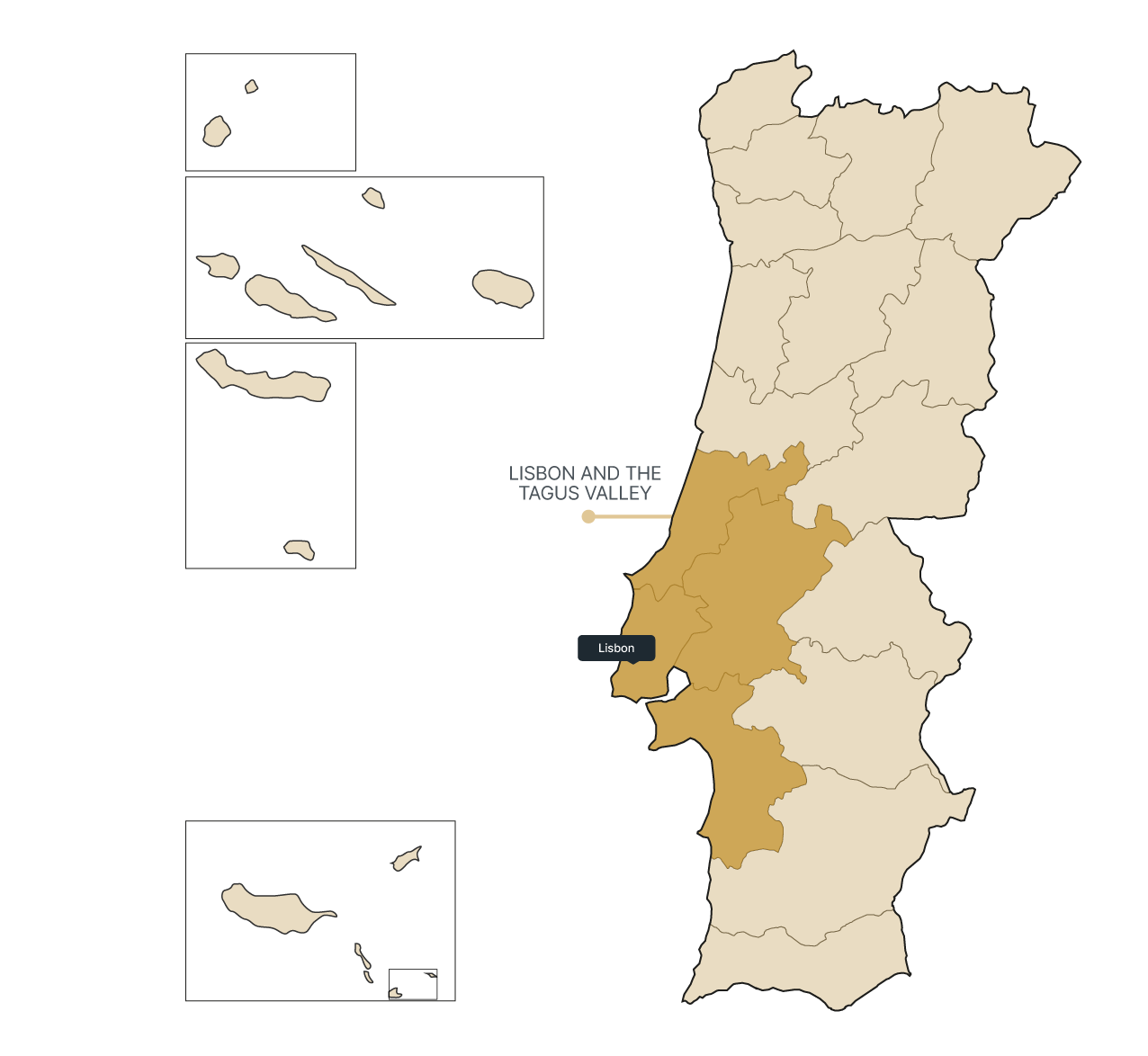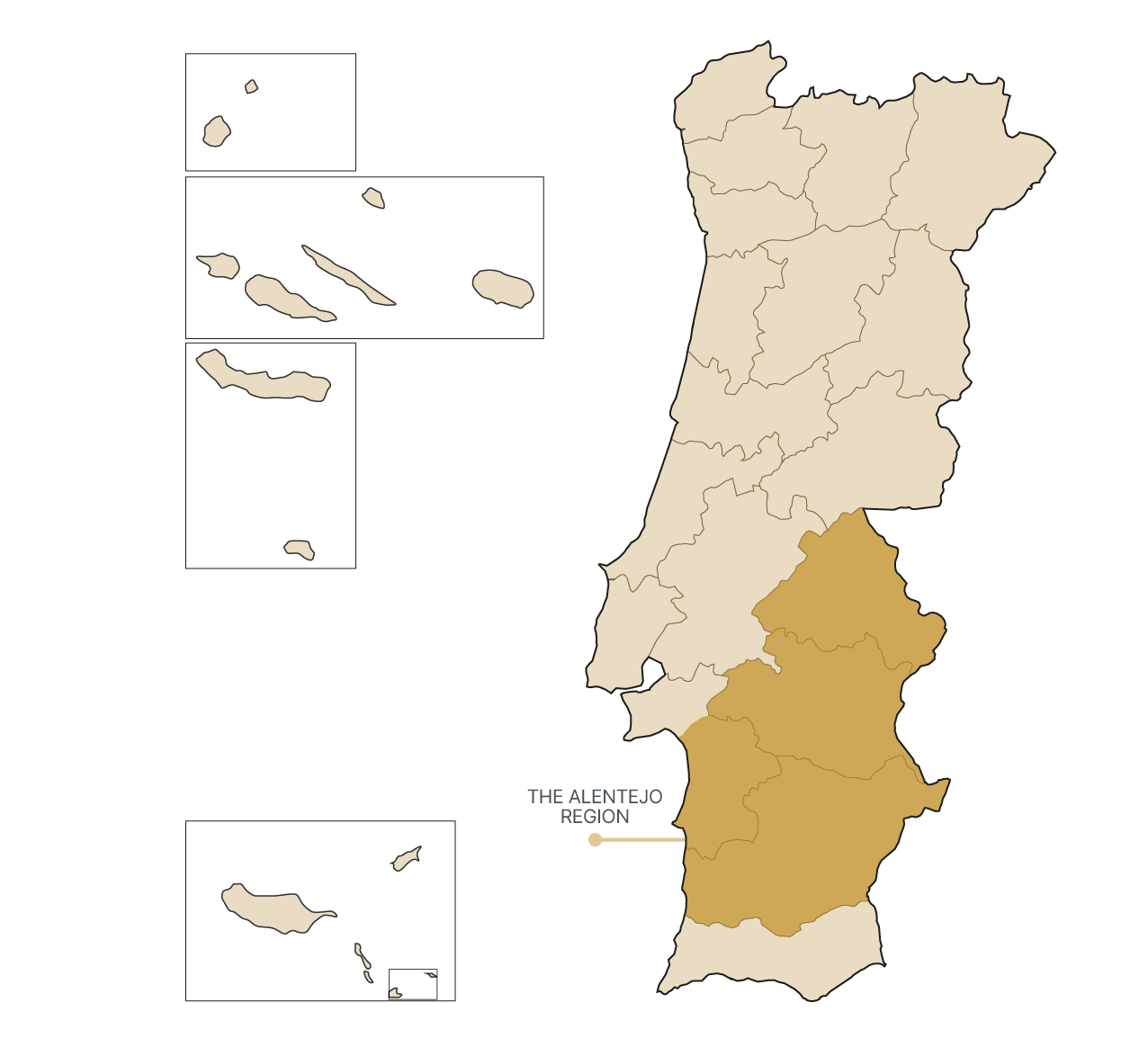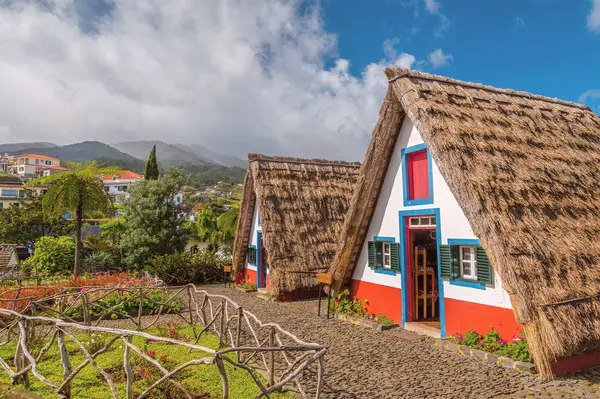
Thousands upon thousands of people flock every year to Portugal, and with good reason. The country has a plethora of benefits to offer, both its residents and citizens, but ultimately – they are just a piece of the puzzle. You may find yourself drawn to iconic Portuguese regions such as Lisbon or the Algarve, and while they do have their unmistakable value, Portugal as a whole has so much more to offer.
Broadly speaking, Portugal has 7 regions, which are divided into 18 districts and 2 autonomous regions:
- The Lisbon and Tagus Valley includes the districts of Lisbon, Setúbal and Santarém;
- The Porto and Northern Region englobe the districts of Porto, Braga, Bragança, Viana do Castelo and Vila Real;
- The Central Region is composed by the districts of Aveiro, Coimbra, Viseu, Leiria, Guarda and Castelo Branco;
- The Alentejo region spans the districts of Beja, Évora and Portalegre;
- The Algarve is all about the Faro district;
- The Azores and its 9 stunning islands: Corvo, Faial, Flores, Graciosa, Pico, Santa Marta, São Jorge, São Miguel and Terceira;
- Madeira archipelago with Madeira and Porto Santo islands.
Each of the regions of Portugal has its own character so distinctly their own, you will be amazed at how unitary the feeling across the country is: if you ask a local, they will always proudly claim to be Portuguese.
Lisbon and the Tagus Valley: Portugal’s Heartbeat

You may envision a city as having towering skyscrapers, neon lights, and bustling streets. Portugal’s capital city, Lisbon, and its surrounding Tagus Valley area is not quite it - the opposite, even.
No less a city and one of the best places to live in Portugal, Lisbon fully provides for all modern needs. However, visiting and living in Portugal’s capital is another feeling altogether, completely different from what you may be used to. Whenever you stroll through Lisbon’s cobbled streets, you will feel as if you have travelled to the past. In Alfama, where a tavern can be found at every other corner, and a note of Fado can always be heard, is perhaps where time has stood still the most. In Belém, another Lisbon district, the past and heritage are honoured, with historic monuments representing Portugal’s seafaring spirit during the Age of Discoveries.
But Lisbon is far from being a city stuck in the past. It is alive with possibilities, where the sun drenches the capital and the surrounding Tagus Valley in an endless shine, even through cloudy, winter days. It is also a city where innovation is fostered, and tomorrow’s future is built. It has lured in global talent in recent years, becoming not only a hotspot for entrepreneurs and creatives seeking a nurturing environment, but also for expats looking for a break and a new lifestyle.
While Lisbon takes the spotlight, we cannot forget about the broader Tagus Valley area. Also referred to as the Lisbon Metropolitan Area, this includes almost the entire Setúbal district, the Lisbon South Bay areas of Sesimbra and Almada, and unmissable, unforgettable iconic villages like romantic Sintra and beach town Cascais.

Porto and the North: The Unyielding Portuguese Soul

Though Portugal’s second-largest city often lies in Lisbon’s shadow, Porto and the wider Northern region stand on their own, bringing about and evoking completely different feelings to anyone who may visit this Portuguese region. If Lisbon is Portugal’s heart, then Porto is its soul. Known as the Cidade Invicta (The Invincible City), Porto is a standing testament of the unyielding Portuguese spirit, which shined the brightest during the Age of Discoveries.
Porto is the city that lent its name to the country. Its ancient name, Portus Cale, would be the Portucalense County’s main town, which eventually became Portugal. Traversing through Porto’s medieval, narrow streets, visiting the city’s many natural parks and spaces, and the locals’ no-nonsense charm and attitude have and will continue to capture the hearts of many expats.
Porto is also the Northern region’s paramount reference, alongside its constant companion, the Douro River and its Valley. The two are so intimately linked that one does not conceivably exist without the other – to the point the internationally acclaimed, sweet wine the Douro Valley produces is named after the city – Port wine.
Like Lisbon, though, the Northern Portugal region goes beyond Porto. There is boundless natural beauty waiting to be uncovered in the Douro Valley’s rolling hills, including the famous vineyards, and in the greater Northern region of Portugal, which also considers the Minho and Trás-os-Montes region. Portugal’s only National Park, Peneda-Gerês, a haven for fauna and flora alike, is also in this stunning Portuguese region.

The Alentejo: Quieter, Rural Countryside Life

While Lisbon and Porto burst at the seams with life, the Alentejo is the safe haven many often covet for peace and quiet, away from the daily multitudes of life. The final frontier before the Algarve region, time truly comes to a standstill in the Alentejo, where golden plains, olive groves, endless vineyards, and vast swathes of Cork tree plantations dot and cover the landscape.
Among this Portuguese region’s busiest cities, Évora and Beja, it is quite common to find the same traits: whitewashed buildings, streaked with coats of blue and yellow. A sight that may seem otherwise dull truly comes as meaningful and traditional that, when combined with the rural lifestyle’s slow pace of living, gives birth to a sensation that is difficult to find anywhere else in Portugal.
If you want to truly understand the Alentejo’s way of contemplating life, look no further than Évora, which won the bid to host the 2027 European Capital of Culture – all based on the concept of vagar – which literally translates to wander, in a particularly unhurried fashion. Though this explanation is vastly oversimplified, it does shed a little light on how the folk from Alentejo understand and view life.
At the end of the day, life out in the Alentejo is not for anyone. But for those who prize simplicity and stress-free life, it is the number one choice when moving or visiting Portugal.

The Algarve: Sun-Soaked Shores and Seaside Living

During the summer, the Algarve actively competes with Lisbon and Porto for the most coveted Portuguese region, and understandably so. When the sun shines the brightest, the Algarve comes to life, with its golden beaches and crystal-clear waters making you almost believe that summer can last forever, and that the sun will never give way into the night.
This entire region brims with activity and sheer fun, especially in the Golden Triangle area, and Faro. Besides traditional beachgoing, the Algarve shines through with the abundance of sea sports, golf courses, a lively nightlife, and the promise of everything seaside living has to offer.
When winter comes, the Algarve loses much of its mainstream appeal. The trees wither, the sun seldom reveals itself, but this brings an almost unnerving beauty. This does not mean it is a region anywhere less worthy to visit, or even moving to. Once the holiday fun fades, and the quiet season begins, the Algarve reveals itself to be an enticing destination, nonetheless.
The more inland you move, the likelier you are to find quiet villages, where fishermen go about their daily lives, setting out to the sea on their boats to provide for their families. If you have a keen taste for seafood, there is no better Portuguese region than the Algarve. Despite the winter’s chilly bite, the weather is mild at best, allowing for daily life to take its natural course. The best part about it is that the ocean has not gone anywhere. The waves still lap and crash at the shore, and to any expat, digital nomad or anyone craving or needing that link to the sea, there is no better place than the Algarve – where the ocean is only ever a short distance away.

Central Portugal: Where Nature and Heritage Meet

While there is much to see and do in Portugal’s other regions, the Central region is, sometimes, often forgotten – which is a tragedy. Much of everyday life in Portugal unfolds here, in the vast areas between Lisbon and Porto.
Truth be told, to put together so many different cities, towns, villages, parks, natural spaces, under a single umbrella as “Central” Portugal is almost a disservice, but the truth is that this wider region includes much of Portugal’s cultural heritage, as well as many natural wonders that will simply take your breath away.
Coimbra is an unmistakable reference in the Central Portugal region. Once the capital of Portugal, this medieval town still is, to this day, an important and essential part of Portuguese culture, with its University – one of the oldest in the world, which captivates many young students to it every year, giving Coimbra an undeniable youthful energy.
If you would rather go on an adventure, the Central Portugal region has much more to offer. Beyond the cityscape, Serra da Estrela glows white underneath the winter sun – the perfect place for snow sports enthusiasts, and the only locale in Portugal to go skiing.
Aveiro is yet another staple in the Central Portugal region – an unmissable trip on any worthwhile tour through Portugal. Also known as the Portuguese Venice, courtesy of the small Ria, where traditional boats called moliceiros course the waterways. This is where the comparisons with the Italian city end and begin, as the city has its own distinct charm – with nouveau art influences, and its own local treat – ovos moles.
Other landmark must-visits include the coastal towns of Nazaré, known for its mounting, cresting waves, perfect for surfing, Ericeira, and Peniche – all with a deep connection to the sea. This Portugal region, with its wide variety of sceneries, including immense, green forests, glistening rivers, and culturally rich cities, make it the perfect destination for both nature lovers and citydwellers alike.

The Azores: The Atlantic’s Wild Beauty

Sometimes, people forget Portugal goes beyond its mainland borders. Though 1600km (around 1000 miles) separate the Azores from the continent, all the 9 volcanic islands remain deeply Portuguese. However, no one would blame you for thinking otherwise, as stepping onto any of them feel as though you are entering a fantasy world ruled by endless swathes of green and blue skies. Look no further than the Seven Cities’ Lagoon, one of Portugal’s most beautiful places, to get a fair idea.
Mirroring the landscape, life in the Azores is all about that deep connection to nature. It is not merely about appreciation for natural beauty, but also to the related health benefits. Due to the islands’ volcanic origins, geothermal hot springs are aplenty. Perfect for any time of the year, but especially during the winter, each of the 9 Azorean islands provide the ideal place for you to disconnect from the noise of the modern world and reconnect with the Earth.
It is also in the Azorean archipelago where you will find the highest physical peak in all of Portugal – on Pico Island, with a recorded altitude of 2.351 meters (around 7710 feet). Between breathtaking views, black and white sanded beaches, volcanic caves, the Azores is the perfect example of just how awe-inspiring nature can be.
Life in this region of Portugal is, admittedly, not for everyone, but will be the ultimate choice for some. A deep sense of modesty, tradition and respect for nature are deeply woven into the Azorean people, reflected in how paramount the industries of agriculture, dairy farming, fishing and ecotourism are for the archipelago, and Portugal as a whole. Much of the milk, cheese and other dairy products consumed by the Portuguese hail from the Azores.

Madeira: Portugal’s Paradise

Closer to Africa than Europe, the Madeira archipelago is no less Portuguese than the Azores. Though the two are often compared, and are remarkably similar in many aspects, Madeira has a completely different feel to it. Unlike its counterpart, it only has two inhabited islands: Madeira and Porto Santo, and its climate is definitely more varied and tropical, where temperatures are always relatively mild, even during winter.
On any given day, you may be able to explore misty forests in the morning, hop on to the beach and enjoy a relaxing afternoon with the sun shining brightly in the sky, and enjoy a glass of Madeira wine as the night draws closer and the sun sets on the Atlantic. When you put it together with the volcanic sights on each of the islands, being physically present in Madeira is a truly one-of-a-kind sensation, unlike anything else in any other Portuguese region. Towering mountains, endless vineyards, levadas – which are irrigation channels turned hiking trails, something only Madeira has – are only some of what Madeira has to offer.
But it is not just Madeira’s climate that entices people. Despite being a natural haven, Madeira still brims with activity in Funchal, the region’s capital. Madeira’s beautiful culture is expressed in so many meaningful ways. Once in Funchal, you cannot miss out on the wicker toboggan rides, or Poncha da Madeira, a typical, local drink, or sightseeing the traditional blue, red and white cottages with thatch roofs. Madeira in the New Years’ celebrations is one of the best times to visit Portugal for some truly spectacular fireworks.
On a side note, you can also roam into the unknown by setting out to explore Ilhas Desertas, a set of uninhabited islands that belong to the Madeira archipelago. If you love sea life, be sure to schedule out in advance a boat tour to the islands and marvel at the sights.

Portugal: A Place to Call Home
When it comes to Portuguese regions, there is no wrong choice. Whether it is Lisbon’s lively streets, the sun-soaked shores of the Algarve, or the rolling green hills of Porto and the North, moving and living in Portugal is the best choice you have yet to make. Each region has its own distinct, unique character, but at the end of the day, they are all Portuguese, which ultimately means one thing: a more relaxed pace of life, more time to spend with the family, untold beauty, and a friendly, warm population that will welcome you with open arms.
All you have to is make that final decision. It may seem daunting to take that first step and to move abroad. But the truth is - it has never been easier, and Portugal Homes makes it even simpler. We are your side from the very first moment, up until you are settled in any of Portugal’s regions, you can rely on us to help you make the transition as smooth as possible. Get in touch with us today and find out how to move to Portugal.














